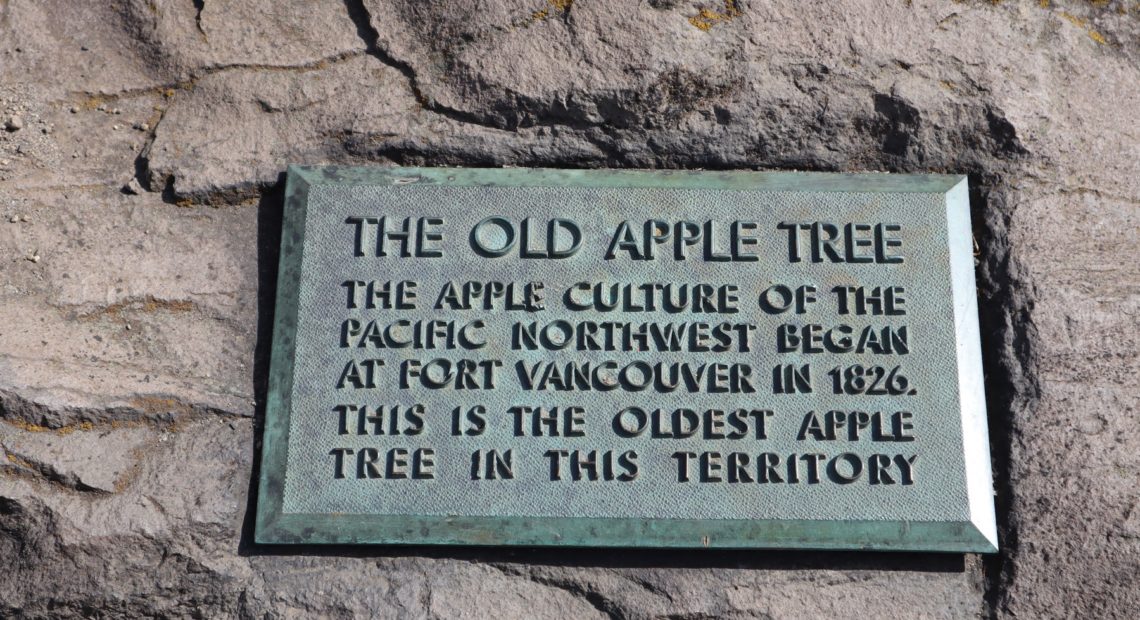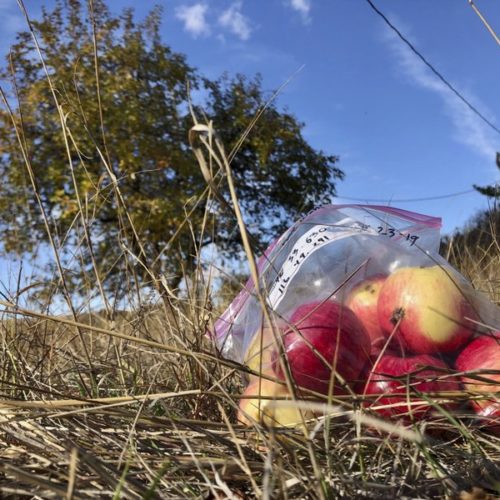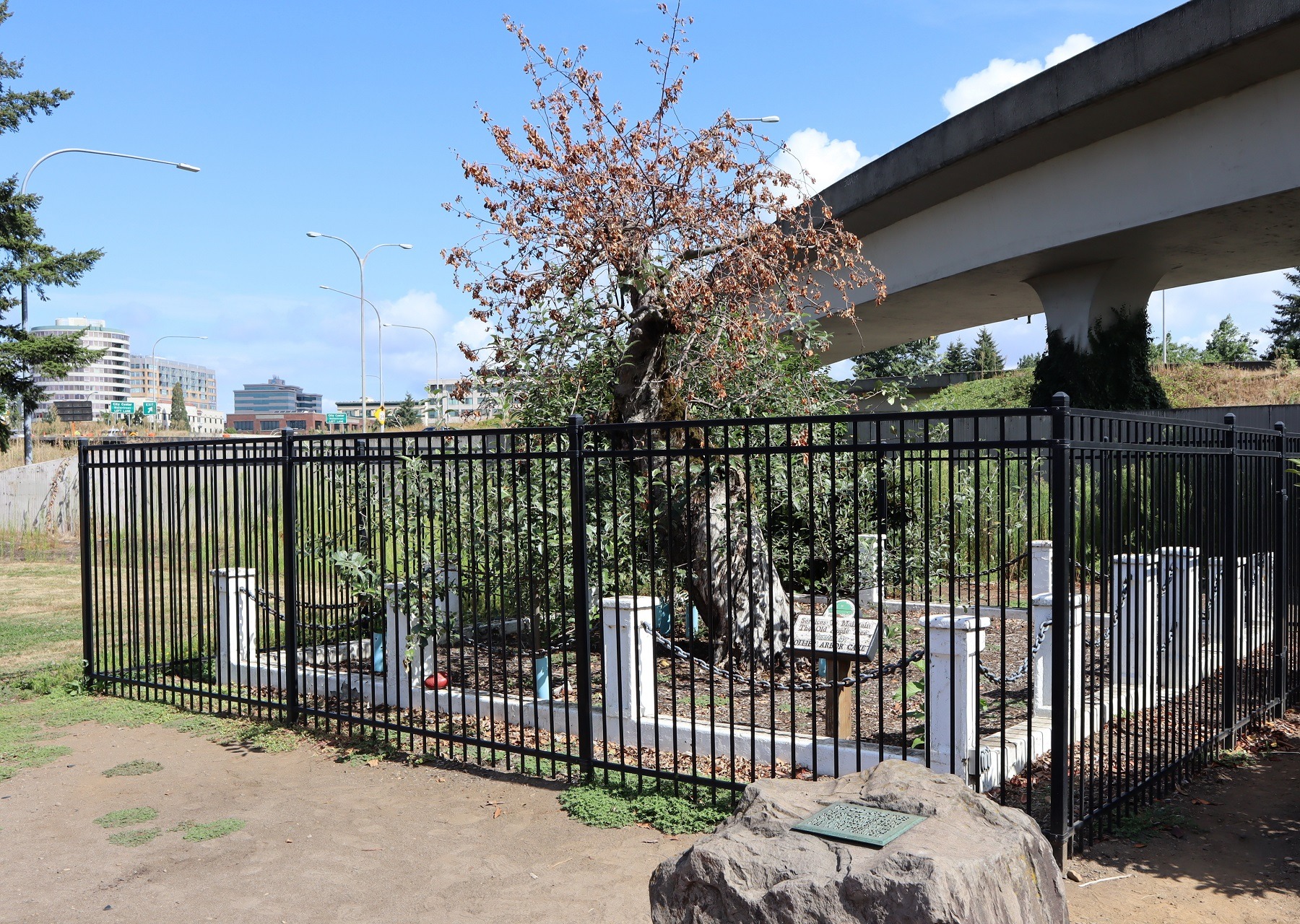
Matriarch Of Northwest Apple Industry Passes Away At Age…194? Yeah, That’s Correct
Listen
It’s not often that you’ll read an obituary for a tree. Or that a dead tree gets a memorial service of sorts. But then there aren’t many like Vancouver, Washington’s “Old Apple Tree.”
“In June, when we started noticing it browning out, we were very concerned,” said Charles Ray, urban forester for the City of Vancouver, Washington. “We were hoping that it was just drought-related and not actually shutting down. So when we found out it was shutting down, it was like losing an old friend.”
Death Notice: OLD APPLE TREE, 1826-2020.
The Old Apple Tree passed away this summer in Vancouver, Washington, at the age of 194. The city identified the causes of death as a spiral crack, decay and old age. Mx. Tree immigrated to the Hudson Bay Company’s Fort Vancouver on the Columbia River as a seed in 1826. She was the only long-term survivor of the first apple trees planted in the Pacific Northwest. As such, the tree is considered the matriarch of the Northwest apple industry. She is survived by many, many descendants — too numerous to list here.
Ray gazed at the remains of the Old Apple Tree last week during a visit to the city park specifically designated to cradle it. The wizened, thick, gray trunk leans crookedly inside a double fence. The enclosure is sandwiched between a freeway interchange, train tracks and the Columbia River. The south end of artist Maya Lin’s Confluence Project “Land Bridge” ends next to the pocket park.
“Since it dates back to the Hudson Bay era, I mean it was the start of the fruit industry in the Pacific Northwest,” Ray observed.
The historic tree produced English Greening apples, a cooking variety that does not appear on grocery store shelves.

The long-standing plaque at the foot of the Old Apple Tree testifies to how the community recognized the significance of the tree early on. CREDIT: Tom Banse/N3
“It’s bitter. It’s most used for baking as well as for horses,” Ray said. “And they are definitely better in apple dishes, whether it’s pie or crisp.”
Later-arriving pioneers on the Oregon Trail and the transcontinental railroads delivered apple cultivars better suited for commercial orchard production. Today, varieties like Gala, Red Delicious, Fuji and Granny Smith dominate the region’s multibillion-dollar industry.
The legacy of the forerunner lives on in other ways.
The Clark County Historical Museum hosted an online remembrance service on Sunday. More than a dozen friends and historians contributed videotaped memories and stories to honor the Old Apple Tree.
Vancouver native Jennifer Hawks-Conright recalled how her parents introduced her to the tree and how she has since passed on the fondness to her own children.
“Going there gave me a love of history that carried on throughout my life,” Hawks-Conright said. “I was just amazed by all the history it had seen.”
Runner Jenny Thompson said she often passed the Northwest’s oldest apple tree while exercising.
“It makes me sad that it is no longer with us,” Thompson said. “But I am grateful that it has its children and grandchildren that are living on.”
There are a lot of those descendants scattered from the Willamette Valley to Seattle. For decades, the City of Vancouver held an annual festival to celebrate the gnarled old tree. Arborists passed out hundreds of cuttings over the years for attendees to take home to plant and have a living connection to the Hudson Bay Co. era. (The Old Apple Tree Festival will resume in 2021, the city said in a recent news release.)

The Old Apple Tree in its glory in 1974, well before a taller fence was built to protect it and a freeway expanded behind it. CREDIT: Hermine Decker Duthie/Clark County Historical Museum
The folklore of how the Old Apple Tree came to be represents another favorite touchpoint. The story begins with a goodbye dinner in London for a young British naval officer scheduled to sail for Fort Vancouver in 1826. An apple dish was served for dessert. A female admirer collected seeds or an apple core from the dessert and gave them to the departing lieutenant.
“‘When you reach your new home in the wilderness, should you ever think of me, plant these seeds,'” said the English lady, as recounted by local Vancouver historian Pat Jollata during Sunday’s remembrance event.
It’s hard to give the tree a proper burial because the oldest apple tree in the territory is wrapped around an axle — literally. Forester Charles Ray said tree lovers propped up the sagging trunk in the 1950s with a castoff car axle. That is one reason besides historic preservation for why the thick trunk will not be chopped down.
The Old Apple Tree is presently surrounded by a bunch of saplings that sprouted from its roots as it declined.
“I picture a grandmother surrounded by her grandchildren,” Ray said. “Perhaps she just realized this was her time now that she has nurtured these grandchildren. It was her time to say goodbye.”
All but one of those shoots, the root suckers, will be transplanted next fall or winter to the replica Fort Vancouver orchard, about a half mile away. One lucky sapling stays in place to become the new Old Apple Tree.
Related Stories:

Apple Varieties Previously Thought Lost Located On The Palouse
Seven apple varieties previously believed to be lost or extinct have been found in eastern Washington, including several on land near the communities of Pullman, Colfax and Moscow.

10 Pioneer-Era Apple Types Thought Extinct Found In The Northwest
A team of retirees that scours the remote ravines and windswept plains of the Pacific Northwest for long-forgotten pioneer orchards has rediscovered 10 apple varieties that were believed to be extinct — the largest number ever unearthed in a single season by the non-profit Lost Apple Project.

The Future Of Apple Breeding May Be Hidden In Ancient Species
Malus sieversii, the ancient apple, seen here in Kyrgysztan. Sieversii comes in many sizes and colors, but are generally inedible. Photo credit: Creative Commons The apple as we know
















